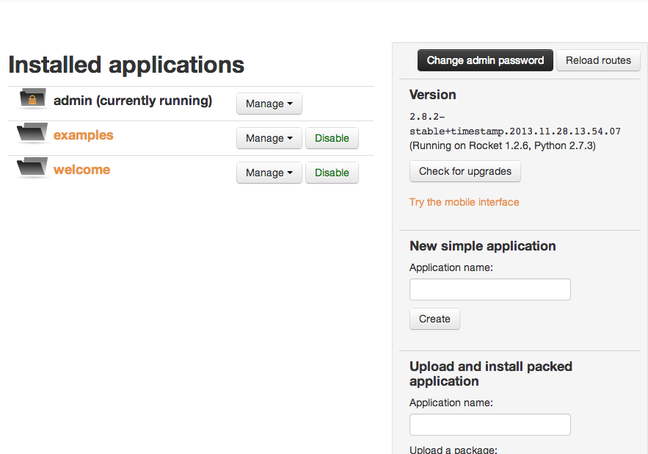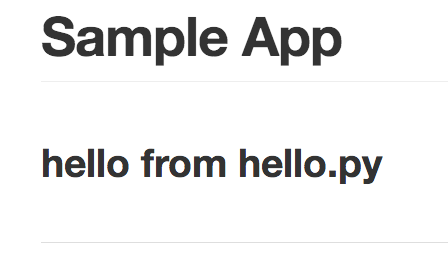Tutorial
How To Use the Web2py Framework to Quickly Build Your Python App

Status: Deprecated
This article covers a version of Ubuntu that is no longer supported. If you are currently operate a server running Ubuntu 12.04, we highly recommend upgrading or migrating to a supported version of Ubuntu:
- Upgrade to Ubuntu 14.04.
- Upgrade from Ubuntu 14.04 to Ubuntu 16.04
- Migrate the server data to a supported version
Reason: Ubuntu 12.04 reached end of life (EOL) on April 28, 2017 and no longer receives security patches or updates. This guide is no longer maintained.
See Instead: This guide might still be useful as a reference, but may not work on other Ubuntu releases. If available, we strongly recommend using a guide written for the version of Ubuntu you are using. You can use the search functionality at the top of the page to find a more recent version.
Introduction
The Python programming language is a versatile, high-level language that can be used easily for web programming, among other tasks. Building web applications can be difficult and toilsome on your own. Web frameworks preform much of the heavy lifting and can set up a template to build your web application easily.
Python has many different web frameworks. One of the most interesting is web2py. Web2py is a full-stack web framework that can be used to completely develop your web app. It has SQL database integration, a multi-threaded web server, and comes with a complete web IDE for designing your program.
This allows you to easily program with a unified interface from anywhere you can access a web browser. You can easily create and test your application in the same interface.
We will be installing and working with this framework on an Ubuntu 12.04 VPS.
Install the Web2py Software
Your Ubuntu server instance should already come with Python installed by default. This takes care of one of the only things that web2py needs to run successfully.
The only other software that we need to install is the unzip package, so that we can extract the web2py files from the zip file we will be downloading:
sudo apt-get update
sudo apt-get install unzip
Now, we can get the framework from the project’s website. We will download this to our home folder:
cd ~
wget http://www.web2py.com/examples/static/web2py_src.zip
Now, we can unzip the file we just downloaded and move inside:
unzip web2py_src.zip
cd web2py
Now that we are inside the web2py directory, how do we install it? Well, one of the great things about web2py is that you do not install it. You can run it right from this folder by typing:
python web2py.py
However, this will only launch the web interface that is accessible on the local machine. This is a security feature, but it doesn’t help us since our framework is being hosted on a remote droplet.
To stop the server, typing “CTRL-C” in the terminal. We will sort out the web access issue momentarily.
Create SSL Certificates to Allow Remote Access
To allow remote access, we must start the web framework with SSL. We need to create our certificates before we can do that. Luckily, the openssl package is already installed.
We can create an RSA key to use for certificate generation with the following command:
openssl genrsa -out server.key 2048
Using this key, we can then generate the .csr file:
openssl req -new -key server.key -out server.csr
Finally, we can use these two pieces to create an SSL certificate:
openssl x509 -req -days 365 -in server.csr -signkey server.key -out server.crt
You should now have a server.key, server.csr, and server.crt file in your web2py directory. We can use these to start up the interface in a secure manner by passing some parameters to web2py when we call it:
<pre> python web2py.py -a ‘<span class=“highlight”>admin_password</span>’ -c server.crt -k server.key -i 0.0.0.0 -p 8000 </pre>
You can select whichever password you would like to use to log into your framework web interface. The “0.0.0.0” allows this to be accessible to remote systems.
You can access the interface by visiting:
<pre> https://<span class=“highlight”>your_ip</span>:8000 </pre>
You should get a warning that says that the SSL certificate is not signed by a known certificate authority.

This is normal, since we signed the key itself. Click the button that allows you to proceed anyways.
How To Use the Web Interface to Design Your Program
Upon visiting the site, you should be presented with the default web2py application:

If you click on the “Administrative Interface” button, you can sign in with the password you just chose when starting the server.
When you’re done, you should be taken to the admin interface:

On the left, you can see three folders. These are actually included sample applications. If you click on the folder titles, you will be taken to the live apps. One is the “admin” interface that you are using now. The “welcome” app is the basic application that you saw before you signed in.
You can edit all of these applications (except the admin) from within this interface by clicking on the “Manage” drop-down menu and selecting “Edit”:

If you did this, get back to the main interface by clicking the “Site” link in the top navigation bar.
Let’s create a new app through the “New simple application” field on the right side of the application. We will name it “sample_app”:

This takes us to the editing interface of our new “sample_app” application. It lists the standard MVC (model, view, and controller) files, as well as a languages directory, a static pages directory, and directories for modules, plugins, and private files.

This is actually just a graphical representation of what is going on in the filesystem. If you were to stop the web server with CTRL-C, and navigate within the web2py directory to the “applications/sample_app” folder, you will see folders that match these categories.
If we visit the site by going to:
<pre> https://<span class=“highlight”>your_ip</span>:8000/sample_app </pre>
We can see that it looks almost exactly like the welcome app that was included by default (the only difference being the title).
Exploring the Web2py’s MVC Implementation
Web2py takes care of a lot of the details necessary to form a fully functioning app. However, you must know how it interacts in order to effectively develop within this system. Web2py implements a policy of “coding-by-convention”.
Coding-by-convention is a design choice selected in order to reduce the number of decisions a developer has to make. This means that a developer should only have to specify when they are moving away from a convention.
For instance, if the controller for an application is called “image_blog.py” and it has a function called “main”, web2py will try to serve this page with a view called “image_blog/main.html”. The “.html” part is the default if no other extension is specified in the controller. If we break this convention, we would have to specify the alternative. Otherwise, this is automatic.
We can see that there is a controller called default.py. This is the default controller that is used when no other is specified. If you click on the “Edit” button to the left of this controller, you can see the functions it defines:

If we return back to the main editing interface (by clicking the “Edit” link in the top navigation bar), we can see that the functions that define user-facing actions have a matching view:

Create A Sample Controller and View
Let’s try this out by creating our own controller first. Under the “Controllers” section, click “Create” to make a new controller:

If we edit this file, we will see that it defines an “index” function that will be called if no other is requested. This serves as a default. This function simply returns a dictionary that stores a variable called message with a value of “hello from hello.py”.
# coding: utf8
# try something like
def index(): return dict(message="hello from hello.py")
You can edit this and click on the disk icon to save your work. For our purposes, this does exactly what we want it to do.
Next, we need to create the corresponding view to render the information that is being passed back (the dictionary that defines message). Click on the “Edit” button or the “<<back” button to return to the app directory.
Under the “Views” section create a new view. We need to match the controller and function for this view to be automatically applied:

Edit the file by clicking the button to the left of it. You should see the default view, which contains something like:
{{extend 'layout.html'}}
<h1>This is the hello/index.html template</h1>
{{=BEAUTIFY(response._vars)}}
This file extends, or builds off of the layout.html view. This is a useful method of keeping a consistent look between all of your pages. If we visit the page in our browser, we can see how it renders.
We can get to this page by visiting:
<pre> https://<span class=“highlight”>your_ip</span>:8000/sample_app/hello </pre>

You can see that it rendered the results in our dictionary below the heading. We can print this directly by editing our view.
If we remove the second two lines, we can replace them with our message text, since it forms the complete message we want to show:
{{extend 'layout.html'}}
<h1>{{=message}}</h1>
Now, we should just see the message that the controller passed, rendered as an h1 header:

If we would like to get rid of the styling, we can remove the top line.
The {{=message}} is a way that we can embed Python code within our files. This allows us to dynamically generate content that is not necessarily available at the time the program is written.
Conclusion
You should now have a very basic understanding of the web2py framework. More importantly, you should be able to see how easy it is to develop on this framework. The flexibility of being able to develop through text files or through a web interface means that you can work well in different environments.
The web interface also comes with a great number of tools for working with your growing application. You can see stack traces when a bug is introduced, you can easily package your application for deployment, and you view a log of all of the errors your application has encountered while developing.
Web2py is a framework, an IDE, and a development suite all in one package.
<div class=“author”>By Justin Ellingwood</div>
Thanks for learning with the DigitalOcean Community. Check out our offerings for compute, storage, networking, and managed databases.
This textbox defaults to using Markdown to format your answer.
You can type !ref in this text area to quickly search our full set of tutorials, documentation & marketplace offerings and insert the link!
Very nice article. and It’s working for me. but When I close Terminal(Putty) It’s not responding. Every time I need to start Web2py server after Closing terminal / Cancel that command. Any solution? Please help me.
@jammaykazx1021: Check out <a href=“https://www.digitalocean.com/community/articles/how-to-install-and-use-screen-on-an-ubuntu-cloud-server”>https://www.digitalocean.com/community/articles/how-to-install-and-use-screen-on-an-ubuntu-cloud-server</a>. It should be fine for a development server but I don’t recommend using <code>screen</code> for running an app on a production server.
@Kamal Nasser Thanks for reply. I know about Screen. I need this for production server so any alternate method?
@jammaykazx1021: Check out <a href=“https://www.digitalocean.com/community/articles/a-comparison-of-web-servers-for-python-based-web-applications”>https://www.digitalocean.com/community/articles/a-comparison-of-web-servers-for-python-based-web-applications</a>.
This tute isn’t working anymore. Could you update it please?
Webradish - you’re a dummy. The tute is fine. Just concentrate! :-)
Thought you wanted to know this material was copied (and even the images are hotlinked) here https://impythonist.wordpress.com/2014/02/15/web2py-a-simpleclean-but-powerful-webframework-in-python/ without do credit.